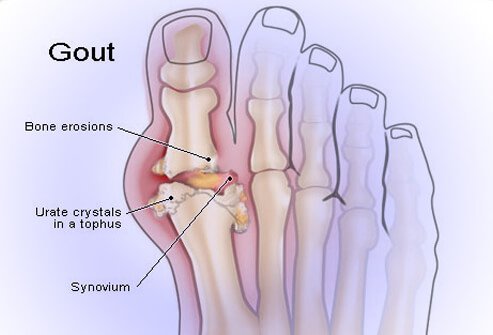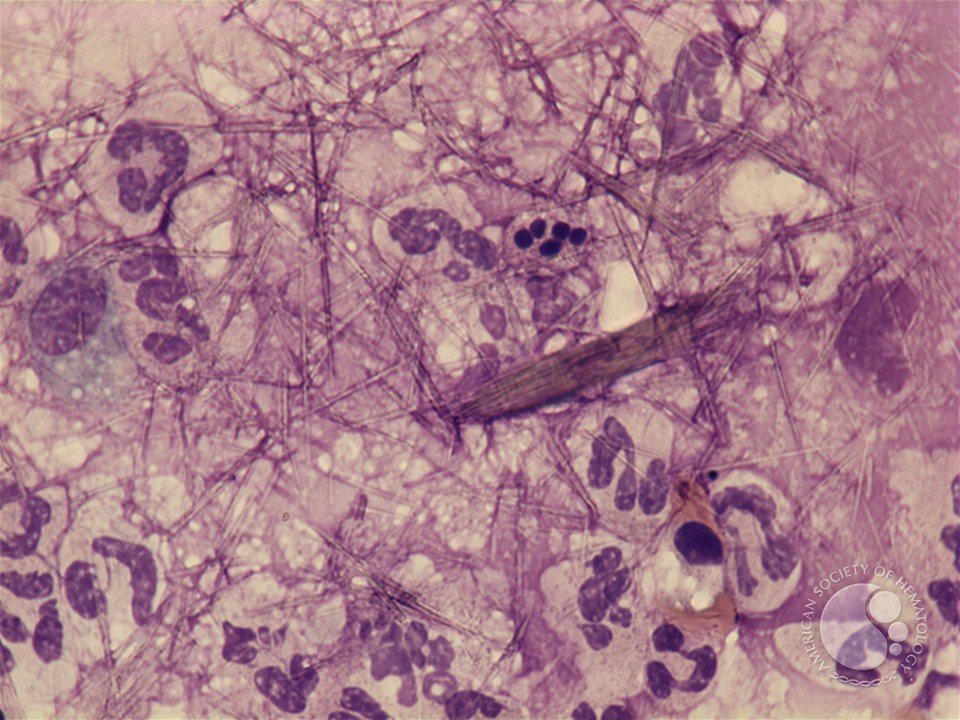Page Contents
OVERVIEW
This page is dedicated to organizing various examples of standardized exam questions whose answer is gout. While this may seem a odd practice, it is useful to see multiple examples of how gout will be characterized on standardized exams (namely the boards and the shelf exams). This page is not meant to be used as a tradition question bank (as all of the answers will be the same), however seeing the classic “test” characterization for a disease is quite valuable.

KEY CHARACTERISTICS OF THIS CONDITION (ON EXAMS)
When it comes to standardized exams, each topic has its own “code” marked by key buzzwords, lab findings, clues, etc. If you are well versed in this code you will be able to more quickly identify the condition that is being discussed, and get the right answer on the exam you are taking. Below is the “code” for gout.
Chief Complaints:
- Arthritis: painful, swollen joint(s). The big toe is a classic site. Onset of symptoms is sudden.
Patient History:
- Arthritis is episodic and can resolve spontaneously/with usage of NSAIDs (more serious cases can be refractory to NSAIDs)
- Smoking is a risk factor
- Alcohol usage is a risk factor
- Obesity is a risk factor
- Poor diet is a risk factor (fatty, high in red meat)
- Myoproliferative disorders (increase rate production) can be risk factors for this condition
Clinical Workup:
- High serum uric acid is often detected
- Crystals (sodium urate crystals) in aspirated synovial fluid. They will be needed shaped and negatively birefringent crystals in nature
QUESTION EXAMPLES
Question # 1
A 65 year old woman comes to the clinic because she is experiencing severe pain and swelling in her left great toe since this morning. She explains that she has been unable to walk using her left foot due to the severe pain. She denies any history of trauma. Her past medical history is notable for hypertension and she takes hydrochloroathiaized and aspiring daily. The patient’s BMI is 32 kg/m2, her temperature is 98.7°F, heart rate is 80/min, respirations are 14/min, and her blood pressure is 145/80 mm Hg. A physical exam reveals swelling and erythema of the force metaccrpophalangeal joint of the left foot. An X-ray of the foot reveals only soft tissue swelling. Aspirated joint fluid from the affected foot shows the presence of sodium urate crystals. What is the diagnosis in this patient?
Explanation # 1
Arthritis of great toe+ sodium urate crystals in joint aspirate = gout
Question # 2
A 50 year old man comes to the ER after he notices a sudden onset of pain and swelling in his left knee. He denies any recent trauma. He has had two similar episodes of pain in the past 5 years, both of which resolved spontaneously. His past medical history is also notable for a history of hypertension that has been treated with enalapril, he has a 10 year history of daily alcohol usage, and he has a 20 pack year smoking history. His BMI is 33 kg/m2, his temperature 99.2°F, pulse is 85/min, respirations are 15/min, and blood pressure is 145/85 mm Hg. A physical exam shows moderate pain and swelling of the left knee, and the range of motion of the knee is limited given the pain. The right knee is unremarkable. What is a likely diagnosis?
Explanation # 2
Arthritis + episodic in nature (resolves spontaneously) + alcohol history + smoking history + obesity = gout
Question # 3
A 55 year old male comes to the hospital because he has been experiencing severe pain in his great toe for the past 2 hours. His pain began suddenly as a dull ache, and not has progressed to a severe throbbing that is not being relieved by taking acetaminophen. His past medical history is notable for hypertension type II diabetes, and hypercholesterolemia. The patient explained that he smokes three packs of cigarettes daily for the past 20 years. He drinks about 4 beers and 4 cups of coffee daily, and eats fast food often. He denies exercising regularly. His current medications include met metformin, losartan, amlodipine, sitagliptin, and atorvastatin. His temperature is 98. 6°F, blood pressure is 165 /90 mmHg pulse is 85 bpm, and respirations are 16/min. His is physical exam is remarkable for a right great toe that appears to be swollen, red, and warm to the touch. What is the likely diagnosis in this patient?
Explanation # 3
Many risk factors for gout (drinking, poor diet, etc) + pain in the great toe = gout
Question # 4
A 57 year old male comes to the ED because he has severe right foot pain that began suddenly when he was taking a nap in the evening. He denies having any such symptoms before. He has a history of type 2 diabetes that has been difficult to control. His BMI is currently 32 kg/m². A physical exam is notable for swelling and tenderness of the first metatarsophalageal joint. Labs reveal a white count of 14,000/µL and his serum creatinine is 0.9 mg/dL. Joint aspiration is performed of the synovial fluid, and microscopical analysis is shown below.

What is the likely diagnosis in this patient?
Explanation # 4
Arthritis of big toe + negatively bifiringent needle-like crystals in synovial fluid = gout
Question # 5
A 65 year old male comes to the ER because he has developed acute knee pain. He has noticed redness, swelling, and pain that emanates from his left knee. He explains that he has had 4 similar episodes in the past that have quickly gone away after he has taken over the counter analgesics. His past medical history is not able for polycythemia vera however he has not been very consistent with receiving his phlebotomy treatments. HIs vital signs are all within normal limits. A physical exam reveal sa left knee that is erythematous and warm to the touch. What is a possible diagnosis in this patient?
Explanation # 5
Arthritis + history of episodic symptoms (resolve with NSAIDs) + history of poorly controlled myoproliferative disorder (polycythemia vera) = gout
Question # 6
A 60 year old male comes to the emergency room because he has been experiencing severe left foot pain. The pain began suddenly, and he denies any recent trauma to his lower extremities. He has noticed redness and swelling but denies having had any fever. His past medical history is notable for hyperlipidemia that has been treated with medications. A physical exam is notable for a swollen first metatarsophalangeal joint. Aspiration of the synovial fluid reveals the presence of many leukocytes, no bacteria, and numerous needle-shaped negatively birefringent crystals. What is the likely diagnosis in this patient?
Explanation # 6
Arthritis of great toe + needle-shaped negatively birefringent crystals = gout
Question # 7
A 65 year old male come sot the clinic to follow up on a recent episode of acute arthritis. He was seen about 1 month ago for a sudden onset of pain and swelling in his ankle. He was treated with an analgesic and received rapid relief of his pain. Since then he states that he has been feeling well and is no longer symptomatic. His past medical history is notable for hypercholesterolemia, and he takes atorvastatin. He also has a history of persistent renal colic. An exam of his ankle is unremarkable. Serum test are conducted and his serum uric acid level is 10.0 mg/dL. What is the likely diagnosis in this patient?
Explanation # 7
Acute arthritis + resolved with NSAID (analgesic) + high serum uric acid level = gout
Question # 8
A 62 year old female comes to the clinic because her right knee has been painful and swollen for the past week. Her vital signs are currently within normal limits. A physical exam reveals a right knee that is erythematous and swollen. She has decreased range of motion. An arthrocentesis is performed and an image of the synovial fluid is shown below.

What is the likely diagnosis in this patient?
Explanation # 8
Arthritis + needle like crystals in synovial fluid = gout
Question # 9
A 60 year old male comes to the clinic because he has been experiencing severe pain and swelling of his right knee. His pat medical history is unremarkable. His vital signs are within normal limits. His physical exam reveals a right knee that is warm, erythematous, and diffusely tender. Synovial fluid from the knee is aspirated and cloudy fluid is removed. Analysis of this fluid shows a leucocyte count of 9300/mm³. Microscopic examination of the fluid shows negatively birefringent, needle-shaped crystals. What is the likely diagnosis in this patient?
Explanation # 9
Arthritis +needle-shaped negatively birefringent crystals = gout
Question # 10
A 55 year old male comes to the clinic because he has been experiencing severe pain and swelling of his left great toe. He explains that his symptoms began after undergoing an appendectomy last week. He explains that his pain is so severe he has difficulty putting on his socks in the morning. He has tried taking celecoxib but that has not provided any relief. A physical exam reveals a toe that is swollen, erythematous, and there is marked tenderness of the metatarsophalageal joint. What is a possible diagnosis in this patient?
Explanation # 10
Arthritis of great toe = (likely) gout
TESTABLE FACTS ABOUT THIS TOPIC (BEYOND ITS IDENTIFICATION)
Many questions on standardized exams go beyond simply recognizing the underlying topic. Often there are specific testable facts regarding some aspect of the topic’s pathophysiology/management/clinical implications that are commonly asked. Some of these are listed below:
Causes/Precipitants Of Acute Gout:
- Niacin (used to manage cholesterol): can decrease renal excretion fo uric acid and can precipitate acute gouty arthritis
Treatment Of Acute Gout:
- indomethacin and naproxen are classic medications to give
- Colchicine is used as second lien therapy
Preventative Treatment Of Gout:
- Xanthine oxidase inhibitors (allopurinol, febuxostat) are used to prevent recurrent attacks of gout because they decrease uric acid production.
Page Updated: 01.22.2017